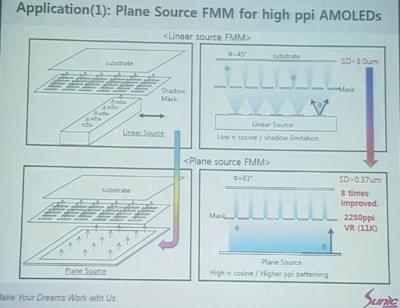One of the key requirements for VR application is high-density displays, as small-sized displays are magnified to cover our whole field of view. Some estimate that realism VR demands around 2,000 PPI.

During SID 2016, Samsung announced it developed a 806 PPI AMOLED especially for VR application. This is an upgrade from current OLEDs, but still a far cry from the 2,000 PPI mentioned above.
In July 2015 SDC announced it launched a new project to develop a 2250 PPI 11K OLED display. Samsung is collaborating with 13 companies on this project, and with the first prototype expected by 2018. Sunic System recently unveiled a new solution that enables 11K 2,250 PPI AMOLEDs, which makes it likely that Sunic is one of the partners in Samsung's project.
Sunic's technology is evaporation-FMM based, and it makes use of a plane source for evaporating OLED materials, as opposed to the currently-used linear source. Plane source technology deposits OLED emitting materials on metal plate and vertically evaporates the materials through heat after reversing that metal plate. This allows a very thin and high resolution FMM possible - which enables high-resolution OLEDs.
Another advantage of this new technology is that it can be used to deposit large-area OLEDs with high density (200 PPI). Up until now FMM itself was limited in substrate size which required companies to cut the substrate before OLED deposition.

